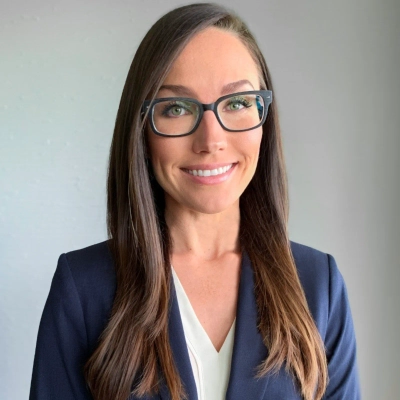18 Tips to Balance Authenticity with Professionalism on Social Media
Social media professionals today face the challenge of balancing personal authenticity with professional boundaries, a topic explored by leading experts in personal branding and digital communication. Their collective wisdom offers practical strategies for creating content that resonates genuinely while maintaining credibility and professional standing. These expert insights provide actionable approaches to developing a distinctive online voice that reflects both personal values and professional expertise without compromising either.
Share Stories with Meaningful Takeaways
Authenticity and professionalism aren't opposing forces, they just need the right context.
I find the balance comes from sharing the story, not the struggle dump. When I talk about lessons learned rather than just challenges faced, my posts feel genuine while still providing real value to the reader.
One simple tip I use: before posting anything, I ask myself, "Would I say this in a client meeting?" If yes, it's both authentic and professional enough. If it feels too raw or reactive, I hold it back until I can shape it into a meaningful takeaway.
People don't connect with perfection; they connect with perspective. Show the human behind the work, but ensure every story you share teaches something useful. That's how you stay real without crossing into oversharing.

Real Journey Sharing Builds Professional Trust
For me, being professional means remaining authentic. Professionalism means sounding honest and genuine, sharing both your victories and failures, which are also part of the professional journey. Instead of striving to showcase only polished results, share more behind-the-scenes moments, challenges, and lessons. It makes your content feel real, and being real is the foundation of authenticity.
Document Values Not Trends for Authentic Voice
We treat our social media as a digital reflection of our agency's culture. Authenticity shows through honest insights, humor, and gratitude. Professionalism shows through consistency, quality visuals, and purposeful messaging. Both matter equally, and neither works without the other. Balance comes from understanding when to speak and when to listen.
A practical tip is documenting tone guidelines that reflect values, not trends. This prevents the brand voice from drifting into imitation. Review tone quarterly to ensure authenticity keeps pace with growth. Adjusting with awareness protects your integrity. Professional presence grows stronger when grounded in evolving honesty.
Balance Emotion with Structure for Meaningful Connection
Striking the right tone begins with honesty and clear communication. Authenticity comes from showing real curiosity. Professionalism ensures that every story is shared with responsibility and care. When discussing educational trends we often highlight what we learned while adapting to them, not just the results. Sharing how learner feedback shaped our digital strategy allowed us to show vulnerability and leadership making our message more relatable and genuine.
The true balance lies in allowing authenticity to express emotion while professionalism gives structure and focus to our thoughts. Together they create a message that feels human and insightful. This combination turns social content into a meaningful conversation rather than self-promotion. It helps build trust encourages reflection and makes every interaction a step toward deeper understanding.
Create Voice Triangle of Values, Expertise, Empathy
We maintain authenticity and professionalism by aligning every post with our core mission. Transparency alone isn't enough — it must support purpose. Our audience engages most when sincerity is paired with strategy. That balance creates a rhythm of openness and authority. Real connection never requires overexposure.
Our tip is creating a "voice triangle" — values, expertise, and empathy. Every post must reflect all three to feel natural yet refined. This framework simplifies tone decisions and strengthens brand consistency. It keeps communication personal but never careless. True professionalism means expressing humanity with precision.

Define Your Brand Voice as Intentional Filter
Having helped countless clients find that sweet spot where authenticity meets professionalism on social media, we've learned it always starts with getting crystal clear on your brand voice.
Before you write a single caption or share a single image, you have to ask: Who are we when we speak? Are we warm and encouraging? Bold and disruptive? Calm and credible? That voice becomes your filter. It ensures consistency, and it gives you permission to be authentic within boundaries that serve your brand.
One of our nonprofit clients struggled with sounding too "corporate" online, which didn't match the emotional impact of their work. So, we helped them reframe their tone to be more human, more heartfelt, without losing professionalism. The transformation was immediate. They started telling real stories, using a first-person perspective, and posting messages that made donors feel a part of their mission, not just understand it.
Similarly, a tech founder we work with didn't want to post anything personal—but still needed to connect. Once we helped define his voice as "thoughtful, insightful, and service-oriented," everything changed. He began sharing ideas that reflected his values, not his private life. And guess what? Engagement went up, not down—because people could hearhim in the posts, even if he wasn't center stage.
My best tip for striking the right tone: Don't default to "professional" as a personality. Default to intentional. Know your voice, write like you're speaking to someone who matters, and remember that authenticity is simply alignment between what you say and what you stand for.
That's the power of brand voice.

Connect Personal Moments to Professional Purpose
The key to professional behavior lies in being present with purposeful intention rather than trying to suppress emotions. I can reveal personal moments or work-related mistakes through my posts because I always connect them to my commitment to care and my ability to explain things clearly.
I test my content by asking myself if I would reveal this information to someone I consider a close friend who needs my honest opinion. The right tone emerges when I answer yes to this question. Authenticity produces better results than artificial perfection in all situations.
Educate with Personality, Not Just Expertise
The key is being both knowledgeable and approachable. I use a playful myth-busting approach on social media where common misconceptions are stated, then I correct them with clinical facts conversationally.
For example, when someone says "Blisters are caused by your shoe rubbing your foot, der!" I respond "Your sock is literally separating your foot and the shoe. It's impossible for your shoe to rub your foot when you're wearing a sock." It's light and engaging, but clinically accurate.
My tip: show personality whilst educating. After 30 years as a podiatrist, I could lecture with jargon, but that doesn't connect. Instead, I acknowledge common beliefs people hold, then correct them with facts that make sense. That self-aware, conversational tone helps people actually listen.
Authenticity comes from genuinely wanting to help people prevent blisters effectively, not just demonstrating expertise. Professionalism comes from ensuring every correction is research-backed. You don't have to choose between being real and credible, you just need to communicate in a way your audience will actually engage with.

Test Posts Through Spoken Words First
I follow a simple approach to writing which involves speaking as if I am on a call with a new client while maintaining professional composure. The way I speak determines my writing style but I refine my natural speech patterns before sharing them with others. I test my posts through spoken words before making them public. The post will have the right tone when it sounds authentic yet delivers information with confidence and clarity.
Regulate First, Then Share With Truth
Authenticity and professionalism aren't opposites they both rely on self-regulation. On social media, I balance the two by noticing my state before I share. If I'm posting from urgency or defensiveness, it won't build trust. But if I regulate first, I can share honestly without oversharing, and lead with clarity instead of reactivity. My tip: draft the post when the emotion is fresh, but don't publish until you've revisited it from a regulated state. That way your content carries truth and steadiness.

Show Up Raw But Keep Message Focused
For me, the balance between authenticity and professionalism comes from showing up as myself, but always with purpose. On LinkedIn I post short, selfie-style videos. There's no studio setup, just me talking directly about SEO or local business growth. The raw format feels real, but professionalism shines through when the message stays focused and useful. My tip: don't overproduce your content. People connect more with a real face and a clear point than with a perfect backdrop.

Demonstrate Technical Competence Rather Than Personality
The idea of balancing "authenticity with professionalism" on social media is backward. In the heavy duty trucks trade, your professionalism is your authenticity. You don't perform a balance; you just showcase the simple truth of your operation.
The core tip for finding the right tone is to Focus on the Physical Part, Not the Personality. Our professionalism is defined by our technical competence, and our authenticity is defined by the real, dirty work involved in the trade. We avoid talking about ourselves or abstract corporate values entirely.
Instead, we use our social platforms to demonstrate the integrity of the OEM Cummins parts we sell. We show the unboxing of a new Turbocharger, the serial number confirmation, and the specific expert fitment support documentation that goes with it. The tone is always direct, instructional, and technically precise.
The biggest factor that maintains this balance is the 12-month warranty. We use the warranty as the measure of our professional truth. If our social media ever implies a promise we can't back up with a physical part and a guarantee, the tone is wrong. Our professionalism lies in that non-negotiable standard. The ultimate lesson is: You don't build a brand on a persona; you build it on the simple, verifiable truth of the product you ship.

Focus on Providing Value, Not Seeking Recognition
In my opinion, authenticity means saying what you believe in with context and self-awareness. When I post on social media, I try to keep it conversational, not corporate, but I also make sure my posts reflect the kind of standards I would expect from my team. You see, the perfect tone comes from the intent. Your tone will sound natural and professional.
If you intend to share value and a perspective, but if you go for likes and to be seen, it makes you lose authenticity. For example, I often share lessons learned from marketing and business experience, but I talk about them in a way that others can learn from, not as complaints or success stories. I strongly believe it's my intent that makes me sound genuine without crossing into unfiltered territory.

Blend Subject Mastery With Personal Authenticity
Finding a good balance of authenticity with professionalism is actually more simple than most people think. There are 2 things that I like to always put in mind: my expertise & my personality. Let's say I would like to publish a content about marketing an online course. I tap into my expertise to create a content that's valuable but I also do not forget that I am... well.. ME. A unique individual who has my own quirks. Thus, I there were plenty of cases where I weave my personality into my videos or social media posts, whether that is adding humor into my videos, writing more emojis in the caption than the usual person, or just simply expressing my true personal opinion on the matter. That's already authenticity right there. If you combine it with knowing your subject matter like it's the back of your hand, voila! You have the perfect balance between authenticity and professionalism. You don't need to overdo things or overcompensate. Your audience will feel that. If you think people don't resonate well, fact of the matter is, they are not your people. The right people will arrive. And when they do, your content is ready.

Write as Though Speaking to Admired Colleagues
I don't believe authenticity and professionalism are opposites - they're partners. The key is intention. Every post should feel human, but it also needs to serve a purpose and align with your values. You can be transparent, conversational, even a little playful, as long as your audience feels you're being helpful, not performative.
Authenticity isn't about oversharing; it's about being consistently credible and relatable.
My rule of thumb:
"Write as if you're speaking to a colleague you admire, not to impress, but to connect."
That mindset helps me maintain a voice that's both real and refined. Over time, it builds the kind of trust that turns professional visibility into true influence.
I treat LinkedIn as my professional home base, where I share insights, trends, and strategic thinking that move the marketing industry forward. Every other platform is a personal space, where I explore creativity, design, and culture from a more relaxed, curious perspective.
That distinction keeps my voice grounded. It lets me bring authenticity to professional spaces and discipline to personal ones, so that everything I share, regardless of platform, still reflects the same clarity of thought and curiosity that defines how I work.

Back Solutions With Data to Build Trust
In the world of social media where everyone is selling or self-promoting, delivering content that provides a solution backed by data, research or evidence immediately builds credibility.
For example, I operate within financial services where self-promotion and direct selling are not methods to increase authenticity. One great example I can give is when I published on LinkedIn comparative data of financial adviser and accountant numbers in Australia and then compared to USA. There was a large disparity between the data sets that wasn't immediately obvious. This generated quite a lot of thought content and outreach, including demand for our services.
This lead to us creating data-backed content that was very closely aligned with our product line. Naturally, our content began to answer buyers' question as it was backed by data and that trust was built.
This is the tip I can give, people want results but are weary of unsubstantiated claims. Include a clear evidence-backed visual element and don't push your sales spiel too hard.
Authentic Without Chaos, Human Yet Authoritative
I don't think there's a one-size-fits-all answer to balancing authenticity and professionalism online-- it really depends on your industry, and how you've chosen to position yourself within it so that you are 'the one' for your ideal client.
If you're in beauty or lifestyle, showing more behind-the-scenes might be expected and create valuable connection with your audience. If you're in a high-stakes sector like finance or legal, a more polished, buttoned-up presence will probably build more trust.
But if you're a founder-led brand or service-based entrepreneur, especially a coach, creator, or thought leader, this gets more nuanced.
Because when YOU are an integral part of the brand, your energy and presence are part of the product and a core driver of your demand.
And especially right now, in the age of AI and automation, human connection is *everything*. Your dream clients aren't just hiring you for your skillset-- they're looking for someone who gets them, who feels grounded and trustworthy, and who they actually want to spend time with.
So yes, people want to see the real you... but that doesn't mean being messy or sharing every thought in real time.
You can be authentic without being chaotic.
You can share your voice without oversharing your life.
You can be warm, honest, and human and still be the authority in the room.
Here's the filter I give my clients:
Before you hit post, ask yourself, "Does this make me more trustworthy?". If it doesn't, it's probably just noise and could even be undermining your brand.

Tailor Content to Platform and Audience
To find the right tone for your social media platforms, you first have to understand your target audience. Who are you trying to attract? I've managed social media platforms for a variety of brands and my tone changed dramatically depending on if I'm trying to reach buttoned-up CEOs who take themselves very seriously, or down to earth tradespeople looking for a laugh.
You should also consider which platform you're publishing on. One of the brands I run right now targets executives of manufacturing and distribution companies with our LinkedIn page, and tradespeople with our Instagram account. Even though it's the same brand, the tone varies depending on which persona is likely to be on which platform.
Once you understand the persona and the platform, you can tailor your content to fit the tone that would most likely resonate with them. However, there are some important nuances. There are pros and cons to being authentic, and there are pros and cons to being professional.
I lean toward being authentic at the expense of professionalism as often as I can. Marketing is about catching people's attention. Too often, brands cling to safe content because they want to be respected as professionals. But they do so at the expense of impact, reach and engagement. If your content is boring, it won't compel your audience no matter the persona. Most brands out there are in far more danger of playing it too safe than they are of being too authentic. Don't be afraid to be real and you might be surprised by how much better you connect with your audience. You'll ultimately have a much easier time calling them to action if they feel connected to your brand.
I'll shoutout my manager of digital content at Trade Hounds as a great example. She's dubbed the meme queen and has earned her title. If you're looking for some inspiration, check out the posts she makes for Instagram. They're funny and relatable. Another company I see doing a great job at being authentic is Jonard Tools. They're funny and unapologetic. You should also check out the Tampa International Airport Instagram. I don't know who runs it but they are hilarious.
Brands get points for getting close to the line even if they accidentally cross it from time to time. Stop being so afraid of being real. Social media is fun.








